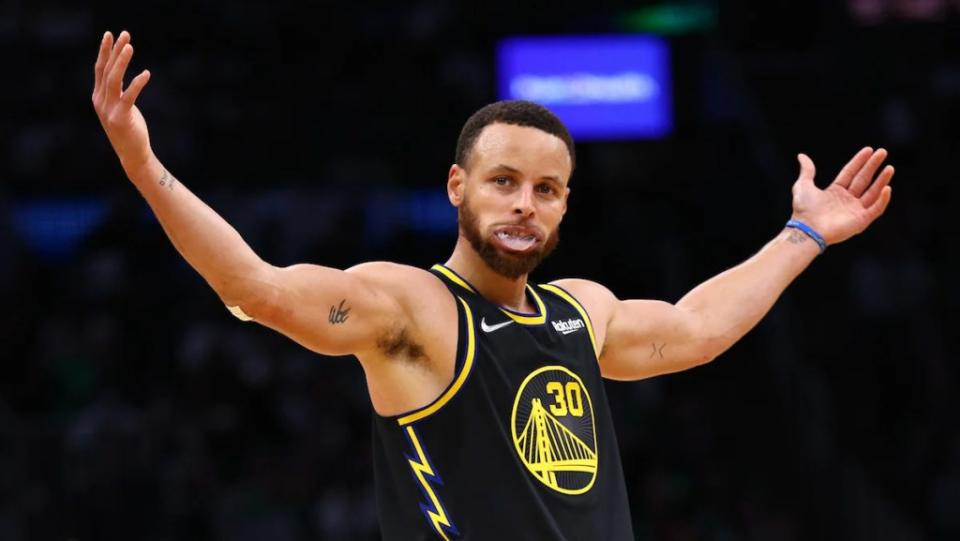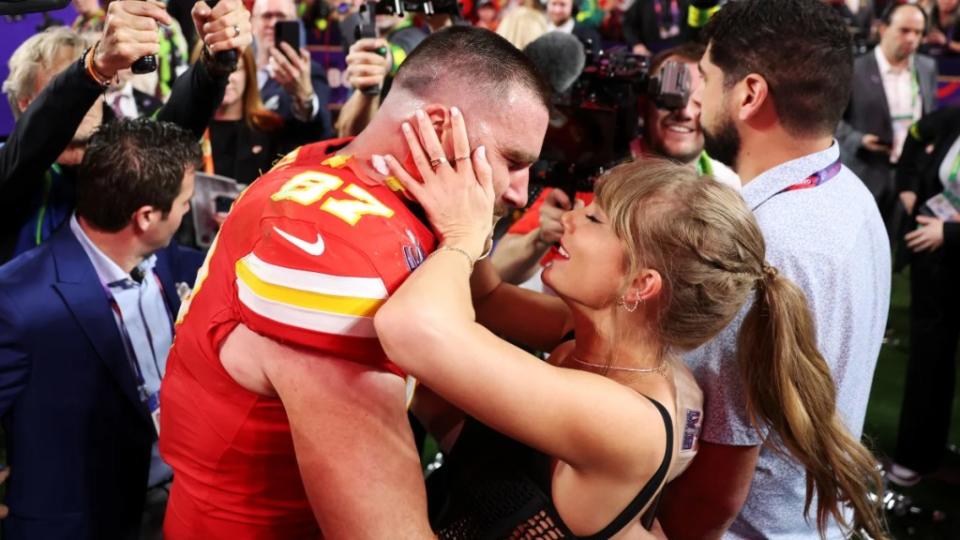NBA’s $76 Billion TV Rights Deal Is Setting the Future for Live Sports | Analysis
The scramble for the NBA TV rights was always destined to be one of the biggest sports stories of 2024. But no one was prepared for exactly how big it would get. As the basketball league expands its number of broadcast partners from two to three, the deal is rumored to pay out $76 billion over 11 years — a package that would be worth more than 2.5 times the league’s current deal.
Disney, Amazon, Warner Bros. Discovery and Comcast are all reportedly circling to get a piece of the brand. Amazon and Disney are all but locked in with offers worth $2.6 billion a year and $1.8 billion a year, respectively, Bloomberg reported. Last week, Comcast threw its hat in the ring, offering the league $2.5 billion a year to steal the rights away from Warner Bros. Discovery-owned TNT. Losing them could be devastating for WBD: Following recent reports that Comcast was close to securing them, WBD’s stock slid 9%.
CEO David Zaslav addressed the issue early Thursday during WBD’s first quarter earnings call, saying conversations were ongoing and noting that WBD had “matching rights that allow us to match third party offers before the NBA enters into an agreement with them.”
In the end, the NBA will be the big winner. “It’s kind of like conquer and divide,” Ken Leon, director of equity research at CFRA Research, told TheWrap. “They’ll get a slice here, a slice there, and they probably will get their $76 billion over 11 years.”
But the battle over the NBA is about more than consistent viewership. As streamers and broadcasters become increasingly desperate for flagship content, the league is pushing to become a global brand and the old, broadcast-centric way of viewing the sport is in the way. The NBA is the latest major sports brand to renegotiate its TV rights for major dollars, a trend of live sports becoming valuable in a landscape with scarce must-see live events. And the data, social media impact and content through commentary that these sports provide are becoming just as important as live games.
“Sports are in such high demand because they deliver things both streamers and networks need more than ever,” Jon Giegengack, Hub founder and principal, told TheWrap. “For one, they’re unique: every platform now has ‘buzzy’ scripted originals, but there’s only one NBA, one NFL, one Premier League.”
In a recent Hub sports survey, 79% of fans said they care more about their favorite sport than other things on TV. And 81% said they would sign up for a new subscription if they needed it to watch a sport they follow.
“Sports are one of the last types of event-driven, must-watch TV, and they’re definitely really desirable and can command those audiences consistently, which is increasingly challenging in the fractured media landscape,” Jamie Lumley, senior analyst at Third Bridge, told TheWrap.

The NBA is far from the only league that’s seen notable growth in TV distribution rights. Earlier this year, Netflix closed in on a 10-year deal for the WWE’s “Monday Night Raw” valued at $5 billion. In addition to Amazon’s commitment to Thursday Night Football, Apple TV+ acquired the rights to “Friday Night Baseball” and “Major League Soccer” and YouTube TV acquired the NFL Sunday Ticket, all of which were multi-billion-dollar deals.
This isn’t the first time the NBA has made history with its TV rights agreement. From 2002 to 2016, the league partnered with the Disney-owned ABC and ESPN as well as Turner Sports for a deal that was worth $766 million a year for its first seven years and $930 million a year for its last eight. That deal was nearly tripled in 2016 when Disney and Turner Sports signed a nine-year extension with a $24 billion payout.
Now history is about to be made again.
The last sure bet on TV, live sports
The NBA isn’t the biggest live sports league in town. That honor belongs to the NFL, which in 2023 averaged 9.2 million viewing minutes per game, according to Nielsen data. In fact, the NFL was responsible for 55% of the total time spent watching live sports.
The NBA has long been a solid second place contender when it comes to widely watched U.S. sporting leagues. Nielsen also found that the NBA averaged 711,000 viewing minutes per game, putting the league ahead of the MLB (378,000 viewing minutes) and NHL (398,000 viewing minutes). Four of the top 10 most valuable sports sponsorships of 2023 were for NBA teams. The other six were MLB teams.
This disparity largely has to do with rules around the various leagues as the NBA and MLB allow for more on-the-field signage than the NFL. The most valuable sports sponsorship was the Los Angeles Lakers’ deal with Crypto.com Arena, which generated an estimated 2.9 million impressions and was valued at over $36 million, based on quality index media value.
While the NFL has historically been the revenue leader, NBA players have much higher social media followings than athletes from other U.S. sports leagues, Bob Lynch, founder and CEO of SponsorUnited, told TheWrap. And since the NBA has a more global audience, any time one of those social impressions blows up it’s an extra boost for brands.
The global and digital appeal of Amazon

The NFL hasn’t just been the leader in viewership and revenue. It was also the first major league to heavily diversify its TV rights contracts. Currently, the league has agreements with Amazon, CBS, ESPN and ABC, Fox and NBC. It would only make sense that the NBA would follow the leader in another way: Partnering with Amazon.
In 2021, Amazon paid $11 billion to secure the rights to Thursday Night Football over 11 seasons. It marked the first time a streaming company had ever secured the exclusive TV rights to the league.
Partnering with the NBA is just another way Amazon is signaling it’s serious about live sports. “If they’re going to deepen their relationship with Prime subscribers, it’s a no brainer for them,” Leon said.
“This could be a loss leader for [Amazon] to get these audiences to continue to be on their platforms more often, which allows them to ultimately convert more customers for all the other things that they can do with those customers,” Lynch said.
The partnership could work both ways. Amazon could help the NBA achieve its global aspirations as well as offer new revenue opportunities.
The NBA has been chasing its dream of being a global league since a 1978 exhibition matchup between the Washington Bullets and Maccabi Tel Aviv. In 2013, the league united its overseas tours under the banner the “NBA Global Games.” In the decade since, it has focused on building bases for the sport in China, India, Australia, Senegal and Mexico, sometimes with mixed results.
During an interview with Goldman Sachs last year, NBA commissioner Adam Silver said that around 1 billion people will watch a portion of a game this season thanks to its reach on social media. Soccer and basketball, he said, “are the two truly global sports.”
There have been some notable setbacks. An academy in India, which offered coaching clinics and visits from NBA stars, changed its model to reach more prospective players. The new model will focus on several smaller centers rather than one large center in Greater Noida. A more complicated matter was the academy in Xinjiang, China, which closed in 2020 following an ESPN investigation. The league declined to say whether or not human rights were a factor when it came to the shuttering but noted that the expansion taught the NBA it needs “more direct oversight” and the ability to make “staffing changes when appropriate.”
Amazon Prime Video, which is currently available in more than 240 countries and territories, could help the NBA with its international aspirations. Most recently, Amazon reached 200 million monthly viewers. “While certainly Warner does have some presence overseas — some of these other players do — it’s not quite at that same scale,” Lumley said.
Beyond globalization, there’s also Amazon’s use of data to consider. The company may not be able to provide a traditional broadcast offering, but it could offer brand information about the buying patterns of its viewers — an “unlock of value beyond the audience that’s actually watching the game,” as Lynch put it.
What Warner Bros. Discovery may lose
Disney has been outspoken about cementing a deal with the NBA. During the company’s earnings call this week, Disney CEO Bob Iger said, “We’re confident and optimistic we’re going to end up with an NBA deal that will be long term and that’s in our best interest and the best interest of our subscribers.”
But Warner Bros. Discovery and Comcast won’t give up easily.
WBD is still working off its debt load from the merger between AT&T spin-off WarnerMedia and Discovery in 2022. From an ad standpoint, WBD trails Disney in year-over-year ad sales by about 50 to 60%, Lynch said. If WBD were to lose the rights, “where do they go from there if they’re not going to be in this space?” he asked.
Zaslav addressed the NBA negotiations on Thursday when he noted WBD’s matching rights. “We’re in continuing conversations with them now, and we’re hopeful that we’ll be able to reach an agreement that makes sense for both sides,” he said. “We’ve had a lot of time to prepare for this negotiation, and we have strategies in place for the various potential outcomes. However, now’s not the time to discuss any of this, since we are in active negotiations with the league.”
If Warner Bros. Discovery were to lose the NBA, it would benefit from a short-term windfall of cash from no longer having to pay the rights fees. Before Netflix swept in and took the rights with a $5 billion deal, WBD was reportedly looking to acquire WWE’s Monday Night Raw.
But “there might not actually be as many dollars left to invest in any other serious properties,” Lumley said. “Again, the top tier sports are certainly doing quite well. It’s a tough market out there.”
After the Hulu sale to Disney, Comcast may have more capital to invest in sports rights. Comcast also owns Peacock, a streamer that has aired games from the NFL, the Premier League and Big Ten football. It will also be home to the 2024 Paris Olympics, which will be the first major live sports test for the streamer. (Due to the time difference, the Beijing Olympics wasn’t as widely watched in the U.S. compared to other years.)
Peacock is “still hovering around that 30 million mark, which for comparison is just over the number of subscribers that Netflix added in the last year,” Lumley said.
The X factor may be how much the streaming players want in on the NBA. Aside from Netflix, all of the major platforms are still struggling with profitability. Disney reported on Tuesday that Disney+ and Hulu — but not ESPN+ — jointly crossed the profitability rubicon this past quarter, with the company quickly warning it couldn’t repeat the feat next quarter.
There’s also the joint streaming app in the works with WBD, Fox and ESPN — which is aimed at “cord-nevers”— a venture that still has many unknowns but may have the ability to disrupt the ecosystem.
“The question is, ultimately, what will sports viewership look like five or 10 years from now?” Lumley asked. “Is the norm going to be that consumers really want to watch it on streaming? Are they going to be willing to pay for it?”
The post NBA’s $76 Billion TV Rights Deal Is Setting the Future for Live Sports | Analysis appeared first on TheWrap.

 Yahoo Finance
Yahoo Finance 